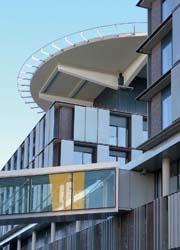"Hospital of the future" opens according to master plan
The staff learned new angles from the patients´ viewpoint by playing a specially-developed game: Klinopoli
The new Clinic of the University Hospital Eppendorf (UKE) in Hamburg, Germany, which opened on 2 February, is part of a "master plan" to transform the UKE into one of the most up-to-date and efficient hospitals in Europe.

That objective has been achieved in five years, said Professor Jörg F Debatin, Medical Director and Chairman of the Board at the UKE. Here he sums up the reasons and philosophy behind this radical modernisation, and how a clever game, devised at the hospital, was used to make the staff more patient-aware.
The old hospital consisted of 172 buildings spread across 38 hectares, Prof Debatin explained. ‘Over the years it became increasingly difficult to match the infrastructure to the size of the UKE,’ he explained. ‘When I started in November 2003, the funding for the UKE master plan was already in place, and included about 340 million euros in funding, part of which was destined for research and teaching and another part, the comparatively small amount of 188 million euros was earmarked for a new 730-bed building.’
The importance of IT
‘Once we checked the existing administrative, medical and logistic operational concepts – and partially redefined them – we could define our requirements for a new IT platform. We now have Sorian (Siemens Medical Solutions), a clinical workplace system that supports all necessary processes within the hospital environment and ensures a largely paperless mode of operation.’
The clinical focus
‘We carried out portfolio analyses at a very early stage and agreed that complex medicine should remain our focus and unique feature. Then we looked at the profitability of individual areas and used those figures as the basis of a benchmark analysis against all German university hospitals. Take obstetrics as an example: In this area, the medical service itself is not very complex. However, because we have the highest number of triplet births in Germany we are highly specialised within the obstetrics field.’
Economics
‘In the last few years we were able to reduce our losses continuously, from 37 million euros in 2003 to five million euros last year. The redevelopment is now complete. We must look to the future because, from my point of view, healthcare for a university hospital is not an end in itself but a means to an end. It is the right means to generate patient collectives and financial means for research, as already successfully practiced by the Americans.
Patient and supply flows
‘We always knew that we would have to separate the flow of patients and supply to increase the efficiency of use of our expensive facilities, such as the operating theatres or even hospital wards. Now we have a sustainable infrastructure in all areas in the new hospital, including nursing: designated rooms for every four wards, a bed-making system for more than 100 beds at a time, no vertical transports etc. We took into account many little details, always with a view to optimising processes.’
Training the 6,000 staff members for new processes and structures
‘With a project of this size, change-management is of vital importance. To use the facilities of the new hospital effectively, it’s very important that all the staff consider the hospital to be ‘their hospital’. Important functional units, such as operating theatres or intensive care wards, were pre-built in full scale in an empty building. The doctors then visited these rooms and confirmed this with their signatures. Following that, there were numerous internal discussions until a consensus was reached. Once that was gained we furnished each type of room and unit with all the respective technology and so on, right down to colour schemes. Finally, the rooms were revisited and inspected by all doctors involved and if there was any justified and constructive criticism we further optimised our design.
‘In my view, the best instrument of change-management was actually a game that we developed specifically for this purpose: Klinopoli. About 4,500 staff members played Klinopoli. The important feature: The game works from, and is based on, the patient’s perspective. Players have to throw dice and make their way around the hospital floor plan. There are chance cards and knowledge questions relating to the new hospital. And depending on how well, or not, you are doing you get out of hospital healthy – or you end up in legal medicine. This really was the best instrument of change-management. It was the first time that all members of staff tried to look at things from the patient’s point of view. That’s how we tried to optimise the hospital from the patient’s point of view.
27.03.2009










